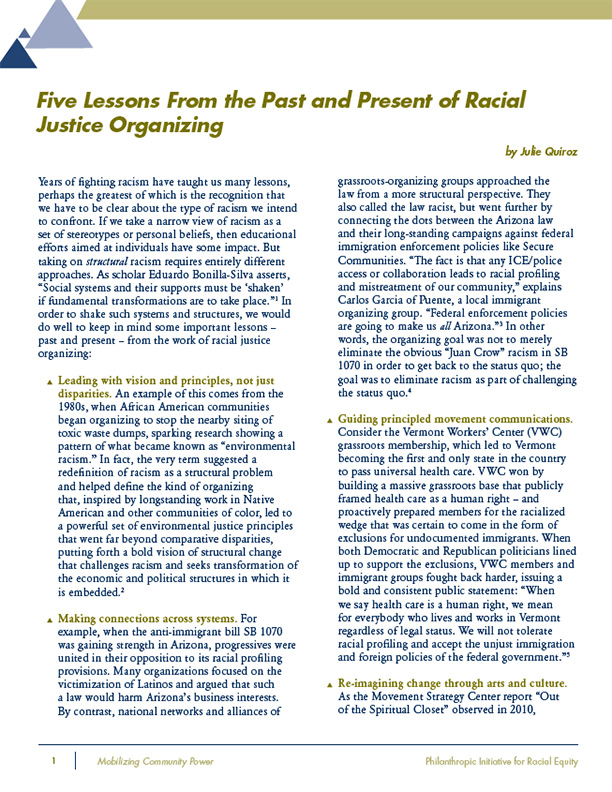Five Lessons from the Past and Present of Racial Justice Organizing
Past and present lessons on organizing with a racial justice lens, published in Philanthropic Initiative for Racial Equity, Critical Issues Forum: Mobilizing Community Power to Address Structural Racism, Volume 4, September 2012.
By Julie Quiroz
Published 2012
Years of fighting racism have taught us many lessons, perhaps the greatest of which is the recognition that we have to be clear about the type of racism we intend to confront. If we take a narrow view of racism as a set of stereotypes or personal beliefs, then educational efforts aimed at individuals have some impact. But taking on structural racism requires entirely different approaches. As scholar Eduardo Bonilla-Silva asserts, “Social systems and their supports must be ‘shaken’ if fundamental transformations are to take place.”
In order to shake such systems and structures, we would do well to keep in mind some important lessons — past and present — from the work of racial justice organizing:
Leading with vision and principles, not just disparities. An example of this comes from the 1980s, when African American communities began organizing to stop the nearby siting of toxic waste dumps, sparking research showing a pattern of what became known as “environmental racism.” In fact, the very term suggested a redefinition of racism as a structural problem and helped define the kind of organizing that, inspired by longstanding work in Native American and other communities of color, led to a powerful set of environmental justice principles that went far beyond comparative disparities, putting forth a bold vision of structural change that challenges racism and seeks transformation of the economic and political structures in which it is embedded.
Making connections across systems. For example, when the anti-immigrant bill SB 1070 was gaining strength in Arizona, progressives were united in their opposition to its racial profiling provisions. Many organizations focused on the victimization of Latinos and argued that such a law would harm Arizona’s business interests. By contrast, national networks and alliances of grassroots-organizing groups approached the law from a more structural perspective. They also called the law racist but went further by connecting the dots between the Arizona law and their long-standing campaigns against federal immigration enforcement policies like Secure Communities. “The fact is that any ICE/police access or collaboration leads to racial profiling and mistreatment of our community,” explains Carlos Garcia of Puente, a local immigrant organizing group. “Federal enforcement policies are going to make us all Arizona.”
In other words, the organizing goal was not to merely eliminate the obvious “Juan Crow” racism in SB 1070 in order to get back to the status quo; the goal was to eliminate racism as part of challenging the status quo.
Guiding principled movement communications. Consider the Vermont Workers’ Center (VWC) grassroots membership, which led to Vermont becoming the first and only state in the country to pass universal health care. VWC won by building a massive grassroots base that publicly framed health care as a human right – and proactively prepared members for the racialized wedge that was certain to come in the form of exclusions for undocumented immigrants. When both Democratic and Republican politicians lined up to support the exclusions, VWC members and immigrant groups fought back harder, issuing a bold and consistent public statement: “When we say health care is a human right, we mean for everybody who lives and works in Vermont regardless of legal status. We will not tolerate racial profiling and accept the unjust immigration and foreign policies of the federal government.”
Re-imagining change through arts and culture. As the Movement Strategy Center report “Out of the Spiritual Closet” observed in 2010, “Movement leaders and organizers within the secular progressive movement are turning to transformative and spiritual practices to help them radically reimagine social change. Collectively, they are generating a transformative approach to movement building that speaks to the needs and challenges of our time.”
Powerful networks and alliances ranging from the Domestic Workers Alliance to Florida New Majority have all made transformative practice a core component of their organizing. Similarly, networks like the National Day Labor Organizing Network have made arts and culture a major focus of their work; NDLON’s website features posters, poetry, and videos that support resistance to dominant ideas and vision for a transformed future.
An emerging national effort called Art Is Change has just developed a capacity-building program that offers cultural strategy development for organizations, alliances, and foundations.
Embodying change, not just demanding it. At key moments in our movements’ history, racial justice organizing has gone from demanding change to embodying change in the creation of alternative structures. One classic example is the movement for community control of schools in New York City in the late 1960s. Fed up with a school system that was failing and even damaging their children, Black and Puerto Rican parents organized, refusing to wait for the promised reforms of Brown v. Board of Education and choosing to believe that they and their community knew what education should look like. Partnering with progressive teachers of color, parents literally took schools over, changing the curriculum to challenge “students to think critically about race relations.”
It remains a moment that challenged purely legal strategies and demanded an anti-racist commitment of a public institution, all while expanding the political imagination of parents and children of color.
Organizing does not always see or challenge structural racism. But it has and it can, making possible the massive shifts this challenge requires.
References are available here.


